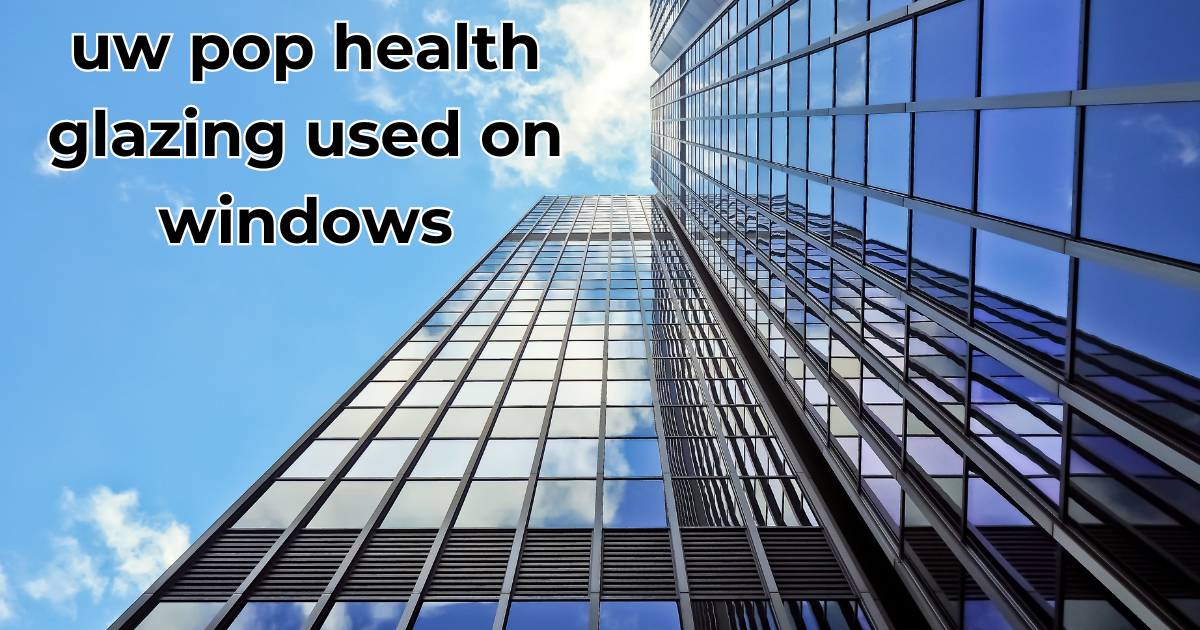In the ever-evolving world of architecture, the integration of health-focused technologies is becoming increasingly vital. One of the most exciting innovations in this realm is UW Pop Health Glazing used on windows. This advanced glazing technology offers significant benefits that enhance not only the aesthetic appeal of buildings but also the health and well-being of their occupants. As architects and builders seek to create spaces that prioritize environmental sustainability and occupant comfort, understanding the benefits and applications of UW Pop Health Glazing becomes essential. This article delves into what UW Pop Health Glazing is, its unique features, applications, benefits, and how it stands out in the landscape of window technologies.
What is UW Pop Health Glazing?
UW Pop Health Glazing is a cutting-edge window glazing solution designed to enhance the indoor environment of residential and commercial spaces. Unlike traditional glazing methods, which primarily focus on thermal insulation and aesthetic appeal, UW Pop Health Glazing emphasizes health and well-being. It is engineered to maximize natural light, minimize harmful UV radiation, and enhance energy efficiency, thereby contributing to a healthier indoor atmosphere. The innovative design incorporates advanced materials that not only improve visibility and aesthetics but also filter harmful elements from sunlight, making it an ideal choice for health-conscious consumers.
This technology combines features such as low emissivity (Low-E) coatings, which reflect heat while allowing natural light to enter, with specialized materials that enhance acoustic performance. By doing so, UW Pop Health Glazing actively contributes to improved air quality, comfort, and overall well-being within indoor environments. This revolutionary approach to window glazing is not just about functionality; it represents a shift toward more thoughtful architectural design that prioritizes the health of occupants and the environment.
The Importance of Health in Architectural Design
Health considerations in architectural design have gained prominence in recent years, particularly in the wake of global health crises and growing awareness of environmental impacts. The built environment significantly affects human health, influencing everything from mental well-being to physical health outcomes. Incorporating health-focused designs into architectural practices not only enhances occupant comfort but also reduces stress and promotes productivity. Elements like natural light, proper ventilation, and sound insulation play crucial roles in fostering a conducive indoor environment.
Windows, in particular, serve as vital components of any building, allowing natural light to flood interior spaces while providing ventilation. However, traditional glazing often falls short of maximizing these benefits. This is where UW Pop Health Glazing used on windows shines. By leveraging innovative glazing technologies, architects can create spaces that not only look appealing but also support the physical and mental health of their inhabitants. This shift in design philosophy marks a significant step toward creating healthier, more sustainable living and working environments.
Key Features of UW Pop Health Glazing
UW Pop Health Glazing boasts several key features that set it apart from traditional glazing options. First and foremost, its energy efficiency is a standout characteristic. The glazing is designed to minimize heat loss during winter and reduce heat gain during summer, leading to significant energy savings for both residential and commercial properties. This efficiency not only lowers energy bills but also contributes to a reduced carbon footprint, aligning with global sustainability goals.
Additionally, UV protection is a critical feature of UW Pop Health Glazing. Standard windows often allow harmful UV rays to penetrate, leading to skin damage and fading of interior furnishings. In contrast, UW Pop Health Glazing incorporates advanced coatings that effectively block these harmful rays while allowing ample natural light to enter. This feature ensures that occupants can enjoy the benefits of sunlight without the associated risks.
Acoustic insulation is another vital aspect of UW Pop Health Glazing. In urban environments, noise pollution can significantly impact occupant well-being. The specialized materials used in this glazing technology provide effective soundproofing, creating a serene indoor atmosphere. Lastly, moisture control features help prevent condensation and mold growth, further enhancing indoor air quality. Together, these features create a holistic approach to window design that prioritizes occupant health and comfort.
How UW Pop Health Glazing Works
The science behind UW Pop Health Glazing used on windows involves advanced materials and innovative engineering techniques. This glazing typically consists of multiple layers of glass, with each layer serving a specific purpose. The outer layer often features a Low-E coating that reflects heat back into the room during colder months while allowing sunlight to enter. This dual functionality ensures that buildings remain warm in the winter and cool in the summer, optimizing energy consumption.
In addition to Low-E coatings, UW Pop Health Glazing employs specialized materials that filter out harmful UV rays. These materials are designed to absorb specific wavelengths of light, effectively blocking harmful rays while allowing visible light to pass through. This unique filtering system not only protects occupants but also preserves the integrity of interior furnishings, reducing fading and wear over time.
Furthermore, the acoustic insulation properties of UW Pop Health Glazing come from the use of laminated glass and interlayers that dampen sound vibrations. This design effectively minimizes noise pollution from external sources, creating a quieter indoor environment. By combining these advanced technologies, UW Pop Health Glazing transforms conventional windows into health-enhancing elements of architectural design.
Benefits of UW Pop Health Glazing Used on Windows
The benefits of UW Pop Health Glazing used on windows extend far beyond aesthetic appeal. One of the most significant advantages is the improved indoor air quality it offers. By minimizing harmful UV radiation and allowing for effective ventilation, this glazing technology contributes to a healthier living environment. Enhanced air quality is linked to better respiratory health, reduced allergies, and overall well-being, making it a valuable addition to any building.
Moreover, UW Pop Health Glazing increases thermal comfort within spaces. By regulating indoor temperatures and reducing drafts, it ensures a consistent and pleasant environment year-round. This feature is particularly beneficial in regions with extreme weather conditions, where maintaining comfort can be challenging. Additionally, occupants benefit from increased daylight exposure, which is known to boost mood, productivity, and overall mental health. Natural light helps regulate circadian rhythms, promoting better sleep and overall wellness.
Furthermore, the energy efficiency of UW Pop Health Glazing leads to significant cost savings. By reducing reliance on heating and cooling systems, building owners can lower their energy bills while minimizing their environmental impact. As a result, this innovative glazing technology not only contributes to occupant health but also offers economic advantages, making it an attractive choice for homeowners and businesses alike.
Applications of UW Pop Health Glazing in Residential Buildings
UW Pop Health Glazing used on windows is becoming increasingly popular in residential buildings, offering numerous advantages that align with modern living standards. Homeowners are increasingly prioritizing health and wellness in their design choices, and this glazing technology fits seamlessly into that narrative. By incorporating UW Pop Health Glazing, homeowners can create bright, inviting spaces that foster well-being and comfort.
One notable application is in modern kitchens and living areas, where natural light is paramount. Large windows featuring UW Pop Health Glazing can illuminate these spaces while protecting occupants from harmful UV rays. This not only enhances the aesthetic appeal of the home but also creates a healthier environment for families to thrive. Furthermore, bedrooms designed with UW Pop Health Glazing can benefit from improved acoustics, ensuring a peaceful night’s sleep away from external noise pollution.
Case studies highlight the successful integration of UW Pop Health Glazing in various residential projects. For instance, a recent home renovation in an urban setting utilized this glazing technology to create a serene oasis amidst the hustle and bustle of city life. Homeowners reported increased comfort, reduced energy costs, and improved overall well-being, showcasing the transformative potential of UW Pop Health Glazing in residential applications.
Applications of UW Pop Health Glazing in Commercial Buildings
The benefits of UW Pop Health Glazing used on windows extend beyond residential spaces and into the realm of commercial buildings. Businesses are increasingly recognizing the importance of employee health and well-being, and incorporating UW Pop Health Glazing into office designs is a step toward achieving that goal. In today’s competitive landscape, creating a healthy and inviting workspace can significantly impact employee productivity and satisfaction.
In open office environments, the use of UW Pop Health Glazing can facilitate better daylight exposure, reducing the need for artificial lighting and creating a more pleasant working atmosphere. Studies show that natural light can enhance mood and focus, leading to improved performance and creativity. Additionally, the acoustic insulation properties of this glazing technology help mitigate distractions from external noise, allowing employees to concentrate on their tasks without interruptions.
Moreover, UW Pop Health Glazing can be effectively utilized in public buildings such as schools, hospitals, and community centers. These spaces can greatly benefit from improved indoor air quality, thermal comfort, and reduced noise pollution. For instance, schools designed with UW Pop Health Glazing have reported lower student absenteeism and higher academic performance, underscoring the positive impact of healthy environments on learning outcomes. By prioritizing occupant health, commercial buildings that utilize UW Pop Health Glazing contribute to the overall well-being of their users.
Environmental Impact of UW Pop Health Glazing
As concerns about climate change and environmental sustainability grow, the environmental impact of UW Pop Health Glazing used on windows becomes an increasingly important topic. This innovative glazing technology is designed not only to enhance occupant comfort but also to minimize its ecological footprint. By improving energy efficiency and reducing reliance on artificial heating and cooling systems, UW Pop Health Glazing contributes to lower carbon emissions associated with energy consumption.
Moreover, the materials used in UW Pop Health Glazing are often sourced and manufactured with sustainability in mind. Many manufacturers prioritize eco-friendly production practices, ensuring that the glazing technology adheres to strict environmental standards. By investing in this type of glazing, building owners can play a role in promoting sustainable construction practices and supporting the development of green technologies.
Furthermore, the longevity of UW Pop Health Glazing means that it requires less frequent replacement, reducing waste associated with traditional window systems. As buildings are constructed to last longer and function more efficiently, the overall environmental impact of the construction and renovation process is significantly decreased. By choosing UW Pop Health Glazing, architects, builders, and homeowners can contribute to a more sustainable future while enhancing the health and well-being of occupants.
Comparing UW Pop Health Glazing with Other Glazing Options
When considering window technologies, it is essential to understand how UW Pop Health Glazing used on windows compares to other available options. Two popular alternatives are Low-E glazing and triple glazing, both of which offer specific benefits but may lack the comprehensive health features of UW Pop Health Glazing.
Low-E glazing is designed to minimize heat transfer while allowing natural light to enter. It is an excellent choice for energy efficiency; however, it does not necessarily prioritize occupant health. Low-E glass can reflect some UV rays but often does not provide the same level of protection against harmful radiation as UW Pop Health Glazing. Furthermore, Low-E glazing typically lacks the acoustic insulation properties that make UW Pop Health Glazing particularly appealing for urban environments.
On the other hand, triple glazing, which consists of three layers of glass, offers superior thermal insulation and energy efficiency. While this option can reduce noise pollution and enhance comfort, it may not prioritize health benefits such as UV protection and improved air quality. In contrast, UW Pop Health Glazing combines the best aspects of these technologies, providing energy efficiency, UV protection, acoustic insulation, and moisture control—all essential elements for creating a healthy indoor environment.
Installation Process of UW Pop Health Glazing
Installing UW Pop Health Glazing used on windows involves a careful process to ensure optimal performance and durability. The installation should be carried out by qualified professionals who are familiar with the specific requirements of this glazing technology. The process typically begins with an assessment of the building’s existing windows and a determination of the most suitable glazing options based on the specific needs of the space.
Once the decision is made to proceed with UW Pop Health Glazing, the installation process includes removing the existing windows and preparing the opening for the new glazing. Proper sealing and insulation are crucial to ensure that the windows perform effectively and provide maximum energy efficiency. Additionally, special care is taken during the installation of the glazing to prevent any damage to the layers or coatings that enhance its health benefits.
After installation, it is essential to conduct a thorough inspection to ensure that the windows are properly sealed and functioning as intended. A well-executed installation not only enhances the performance of UW Pop Health Glazing but also contributes to the longevity of the windows, ensuring that they continue to provide the intended health and environmental benefits for years to come.
Maintenance of UW Pop Health Glazing
To ensure the long-lasting performance of UW Pop Health Glazing used on windows, regular maintenance is essential. One of the key advantages of this glazing technology is its durability; however, proper care is still necessary to maintain its optimal functionality. Routine cleaning is the first step in maintaining these windows. Homeowners and building managers should clean the glass surfaces using mild soap and water, avoiding abrasive cleaners that could damage the protective coatings.
Inspecting the seals and frames periodically is also crucial. Any signs of wear, moisture buildup, or air leaks should be addressed immediately to prevent further damage. If issues are detected, it is advisable to consult a professional to evaluate the condition of the glazing and make necessary repairs. Proper maintenance not only extends the lifespan of UW Pop Health Glazing but also ensures that its health-enhancing properties remain effective.
Additionally, it is important to keep the areas around the windows clear of obstructions to allow for proper ventilation. This practice can help prevent moisture buildup and potential mold growth, further enhancing indoor air quality. By implementing a regular maintenance routine, property owners can maximize the benefits of UW Pop Health Glazing and create a healthier living or working environment.
Also Read: Trymagbag
Cost Analysis: UW Pop Health Glazing Used on Windows
When considering UW Pop Health Glazing used on windows, it is essential to analyze the costs associated with installation and long-term benefits. While the initial investment for this advanced glazing technology may be higher than traditional options, the long-term savings it offers can outweigh these costs. Energy efficiency is one of the primary benefits; by reducing heating and cooling costs, homeowners and businesses can experience significant savings over time.
Additionally, the health benefits associated with UW Pop Health Glazing can lead to lower healthcare costs due to improved indoor air quality and reduced allergy symptoms. Healthier indoor environments contribute to enhanced productivity, which can be particularly beneficial for businesses aiming to maximize employee performance. Over time, the investment in UW Pop Health Glazing can result in a positive return on investment through increased comfort, reduced energy bills, and improved occupant health.
Moreover, various financial incentives, such as rebates for energy-efficient upgrades, may be available to property owners who choose to install UW Pop Health Glazing. These programs can further offset the initial costs and make this innovative glazing technology more accessible to a broader range of consumers. Ultimately, the combination of health, environmental, and economic benefits makes UW Pop Health Glazing a smart choice for those looking to enhance their living or working spaces.
Regulatory Standards and Certifications
As the demand for health-focused building technologies increases, regulatory standards and certifications for products like UW Pop Health Glazing used on windows are becoming more critical. Various organizations and regulatory bodies have established guidelines to ensure that glazing technologies meet specific performance and safety criteria. These standards often encompass energy efficiency, UV protection, and indoor air quality.
One notable certification is the ENERGY STAR® label, which identifies products that meet stringent energy efficiency guidelines set by the U.S. Environmental Protection Agency. Glazing technologies that achieve this certification indicate a commitment to energy conservation and environmental sustainability. Additionally, certifications from organizations such as the National Fenestration Rating Council (NFRC) provide valuable information on the performance characteristics of glazing products, helping consumers make informed decisions.
Furthermore, LEED (Leadership in Energy and Environmental Design) certification is increasingly sought after by building projects aiming for sustainability. Incorporating UW Pop Health Glazing into a building can contribute to achieving LEED credits, as it enhances energy efficiency and supports occupant health. By choosing glazing technologies that comply with these standards and certifications, property owners can ensure that they are investing in high-quality products that align with contemporary health and environmental goals.
User Testimonials and Case Studies
Real-world applications of UW Pop Health Glazing used on windows provide valuable insights into its effectiveness and benefits. Numerous user testimonials highlight the positive impact this glazing technology has on daily life. Homeowners often report significant improvements in comfort levels, citing enhanced natural light and reduced noise pollution as key factors in their satisfaction. For example, a family living in a bustling urban area noted that their home became a serene retreat after installing UW Pop Health Glazing, allowing them to enjoy peaceful evenings without the distraction of outside noise.
Commercial users have also shared success stories about the benefits of UW Pop Health Glazing. Businesses that incorporated this technology into their office designs reported increased employee satisfaction and productivity. For instance, a tech company that invested in UW Pop Health Glazing for its new office space observed a marked improvement in employee morale and creativity, attributing these changes to the increased daylight exposure and improved indoor environment.
Case studies further illustrate the transformative potential of UW Pop Health Glazing in various settings. From modern residential homes to large commercial buildings, the consistent feedback emphasizes the technology’s role in enhancing occupant health and comfort. These testimonials serve as powerful endorsements for UW Pop Health Glazing, demonstrating its effectiveness in creating healthier, more enjoyable living and working spaces.
Future Trends in Window Glazing Technology
The field of window glazing technology is continuously evolving, with UW Pop Health Glazing used on windows at the forefront of innovation. As awareness of health and environmental concerns grows, the demand for glazing solutions that prioritize occupant well-being is likely to increase. Future trends in window glazing may include the development of even more advanced materials that offer enhanced energy efficiency, improved UV protection, and greater acoustic insulation.
Smart glazing technology is also gaining traction, with innovations that allow windows to adapt to changing environmental conditions. For instance, self-tinting or electrochromic glass can adjust its transparency based on sunlight exposure, optimizing energy usage and indoor comfort. This technology could complement UW Pop Health Glazing by further enhancing its health and environmental benefits.
Additionally, as sustainability becomes a critical focus for the construction industry, manufacturers may explore new eco-friendly materials and production processes. Innovations in recycling and repurposing existing glazing materials could lead to more sustainable practices in window manufacturing. Ultimately, the future of window glazing technology will likely be shaped by a combination of health-focused innovations, sustainability initiatives, and advancements in smart technologies, positioning UW Pop Health Glazing as a pivotal component of this evolution.
How to Choose the Right Glazing for Your Project
Choosing the right glazing for a project can be a daunting task, especially with the myriad of options available in the market. When considering UW Pop Health Glazing used on windows, several factors should be taken into account to ensure the best fit for your specific needs. First, it is essential to assess the intended use of the space. For example, residential applications may prioritize comfort and aesthetics, while commercial projects might focus on energy efficiency and employee well-being.
Next, consider the climate and environmental conditions in your area. Different types of glazing perform differently under various weather conditions, so understanding local climate patterns can help determine the most suitable glazing option. UW Pop Health Glazing excels in regions with extreme temperatures due to its energy-efficient properties, making it an ideal choice for homeowners looking to maintain consistent indoor temperatures year-round.
Finally, consulting with professionals can provide valuable insights into the selection process. Architects and window specialists can help evaluate the specific needs of your project, recommend appropriate glazing technologies, and ensure that the chosen solution aligns with health and sustainability goals. By carefully considering these factors, you can make an informed decision that enhances the overall quality and functionality of your building.
Integrating UW Pop Health Glazing with Other Design Elements
Integrating UW Pop Health Glazing used on windows with other design elements can elevate the overall aesthetic and functionality of a space. One of the key advantages of this glazing technology is its versatility, allowing it to complement various architectural styles and interior designs. Whether you are working on a modern minimalist project or a more traditional design, UW Pop Health Glazing can seamlessly fit into the overall vision.
In addition to aesthetics, consider how UW Pop Health Glazing interacts with other design elements such as lighting, furniture, and color schemes. The natural light that filters through this glazing can enhance interior spaces, creating bright and inviting atmospheres. Using lighter color palettes in conjunction with UW Pop Health Glazing can amplify the effects of natural light, resulting in spaces that feel more open and welcoming.
Furthermore, integrating smart home technology with UW Pop Health Glazing can enhance its functionality. Automated window coverings or shading systems can work in harmony with the glazing to optimize light control and energy efficiency. This combination creates an adaptable indoor environment that promotes occupant comfort and well-being. By thoughtfully integrating UW Pop Health Glazing with other design elements, you can create spaces that are not only beautiful but also prioritize health and sustainability.
Educational Resources and Workshops
As awareness of UW Pop Health Glazing used on windows continues to grow, educational resources and workshops are emerging to help architects, builders, and homeowners understand the technology’s benefits and applications. These resources provide valuable information on the science behind UW Pop Health Glazing, installation techniques, and maintenance best practices.
Workshops often feature expert speakers who share insights into the latest trends in window glazing technology and its impact on health and sustainability. Participants can learn about the various features of UW Pop Health Glazing, explore real-world case studies, and engage in discussions about best practices in architectural design. These educational opportunities empower attendees to make informed decisions about glazing technologies for their projects.
Additionally, online resources such as webinars, articles, and instructional videos provide accessible information about UW Pop Health Glazing. These resources can serve as valuable references for those looking to deepen their understanding of this innovative technology and its applications. By investing time in educational initiatives, stakeholders in the building industry can stay informed about advancements in glazing technology and incorporate health-focused solutions into their projects.
The Role of Architects in Promoting UW Pop Health Glazing
Architects play a crucial role in promoting UW Pop Health Glazing used on windows and advocating for health-focused design principles. As key decision-makers in the architectural process, architects have the opportunity to influence the materials and technologies used in their projects, prioritizing occupant well-being and sustainability. By incorporating UW Pop Health Glazing into their designs, architects can create spaces that enhance health, comfort, and productivity.
Furthermore, architects can educate clients about the benefits of UW Pop Health Glazing, helping them understand the long-term value of investing in health-focused technologies. By presenting compelling case studies and evidence-based research, architects can demonstrate how this glazing technology aligns with contemporary design philosophies and contributes to healthier indoor environments.
Additionally, architects can collaborate with manufacturers and industry stakeholders to further develop and promote innovative glazing solutions. By participating in industry events, sharing insights with peers, and engaging in research initiatives, architects can play an active role in advancing the adoption of UW Pop Health Glazing and similar technologies. Through their leadership and advocacy, architects can shape the future of building design, prioritizing health and sustainability for generations to come.
Conclusion
In conclusion, UW Pop Health Glazing used on windows represents a significant advancement in architectural design, prioritizing health, comfort, and sustainability. This innovative glazing technology offers a multitude of benefits, from improved indoor air quality to enhanced energy efficiency, making it an attractive choice for both residential and commercial applications. As awareness of the impact of the built environment on health continues to grow, integrating health-focused design principles into architecture becomes increasingly vital.
By choosing UW Pop Health Glazing, architects, builders, and homeowners can create spaces that promote well-being, productivity, and sustainability. The future of glazing technology holds exciting possibilities, with advancements that will further enhance the health benefits of windows. As we move toward a more health-conscious approach to design, the integration of UW Pop Health Glazing is a crucial step in shaping healthier, more vibrant living and working environments. By embracing this innovative technology, we can contribute to a future where buildings not only serve as shelters but also enhance the quality of life for their occupants.










